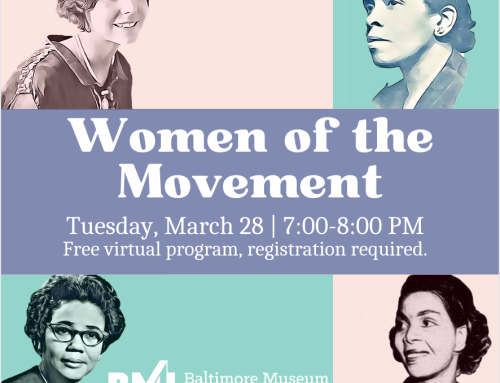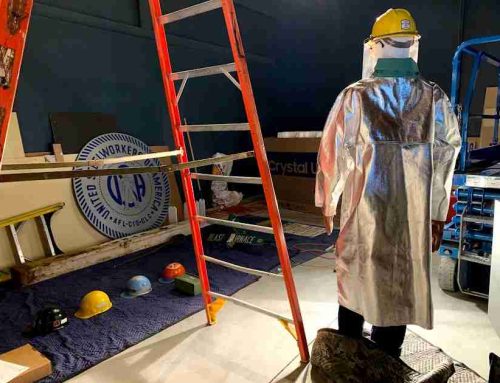
by Auni Gelles

Ernestine Scott (right) poses with the brick honoring her father, John Washington Jr., who was the first Black crane operator in the tin mill. Photo by Mary Braman.
Spring 2022 marked a decade since steelmaking ceased at the Sparrows Point steel mill. Founded by the Pennsylvania Steel Company in the 1890s, this Baltimore County mill reached its peak production in the 1950s and was once the largest steel plant in the world. Often associated with Bethlehem Steel, the company that owned and ran it between 1916 and its bankruptcy in 2001, the plant went through five different owners in its last decade. RG Steel filed for bankruptcy on May 31, 2012, when the 2,100 remaining steelworkers lost their jobs.
2012 may feel like just yesterday for some of us, but it can feel like distant and even unfamiliar history to many museum visitors and newcomers to the Baltimore area. We welcome thousands of third and fourth graders to the BMI on field trips, and this generation has no living memory of a steel industry in Baltimore. I was living and working in Baltimore around 2012 but never saw the mill in operation. Despite reading and hearing about the topic for the past 3+ years as part of the museum’s Bethlehem Steel Legacy Project, I still have trouble envisioning the scale of steelmaking operations at Sparrows Point.
The museum aimed to bridge that gap with “Ten Years Since Steelmaking Stopped at Sparrows Point,” a day of programs honoring that somber anniversary, on June 5, 2022. Approximately 30 former steelworkers came together, along with friends and family, to remember their time at the Point and reflect on what has changed over the last decade. Photojournalist J. M. Giordano led a tour of his temporary exhibition, “Shuttered: Images from the Fall of Bethlehem Steel,” with 15 years of photographs capturing the impact of the mill’s decline and closure on his hometown of Baltimore. Curator Deb Weiner led a discussion of the BMI’s newest long-term exhibition “Fire & Shadow: The Rise and Fall of Bethlehem Steel,” in conversation with BMI Trustee (and metallurgical engineer) Quincy Goldsmith.

Deb Weiner and Quincy Goldsmith stand in front of the “Fire & Shadow” exhibition. Photo by Mary Braman.
We formally dedicated the Bethlehem Steel Legacy Garden at the base of the Bethlehem Steel shipyard “Whirley Crane,” with remarks from steel industry veteran Joe Lawrence, Sparrows Point resident and one-time employee Sandy Adams Doyle, and steelworker’s daughter Ernestine Scott. We heard remarks from Aaron Tomarchio of Tradepoint Atlantic, the company that has redeveloped the peninsula into a global logistics hub and that generously supported the museum’s multi-year initiative.

Joe Lawrence poses with his family at the Bethlehem Steel Legacy Garden at the BMI. Photo by Mary Braman.
Another highlight of the day was a pop-up “Portrait Studio” inside the museum, where Bethlehem, PA-based photographer Edward Leskin, MFA, took professional portraits of 10 steelworkers as part of his ongoing project “Images of Flesh and Steel.” Ed has worked extensively with the Steelworkers’ Archives and the National Museum of Industrial History in Bethlehem, PA, to document the individuals who made up Bethlehem Steel. We’re planning a virtual program in October featuring the photography portfolio of Ed Leskin and J. M. Giordano–stay tuned for details.




